REDLANDS, Calif. - On a windy, frigid January morning, volunteers gathered before dawn at the Redlands Community Center. Equipped with maps, smartphone surveys, and supplies, volunteers prepared to walk the streets and open spaces in Redlands to count how many people had spent the night outdoors.
The annual point-in-time (PIT) count provides a hazy snapshot of the local unhoused population, a community that's often difficult to keep track of.
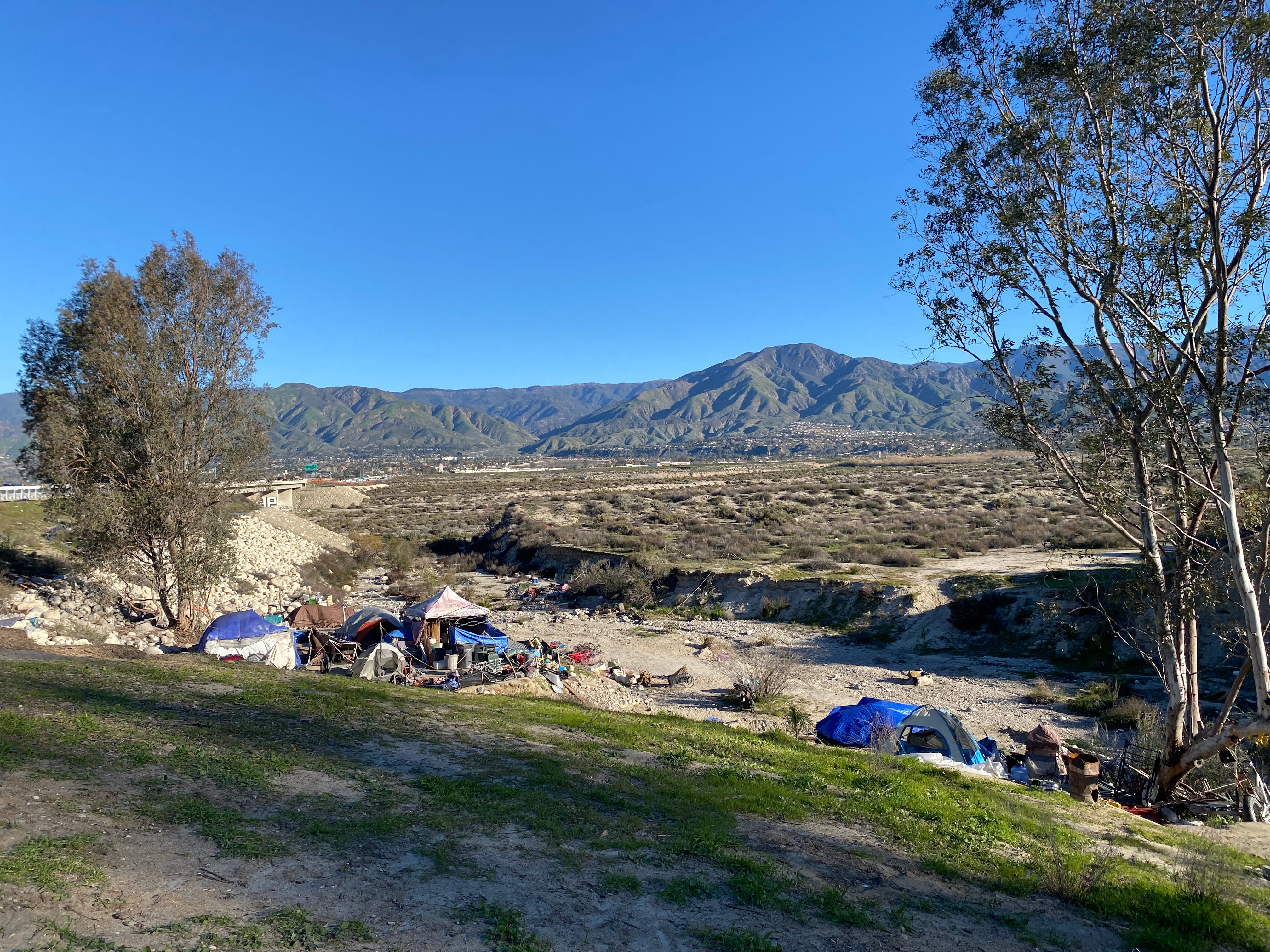
I joined a group of surveyors driving through the Santa Ana River Wash. We only encountered a handful of people during the entire 2 hours they surveyed the area. I was told it was a good sign that not many people were around. After months of outreach, some had already been placed in Redland's new permanent supportive housing.
We met a man named Michael living under the drainage pipe near the Santa Ana Wash. He said this was the first time someone reached him with resources in the three years he had lived there. He was grateful.
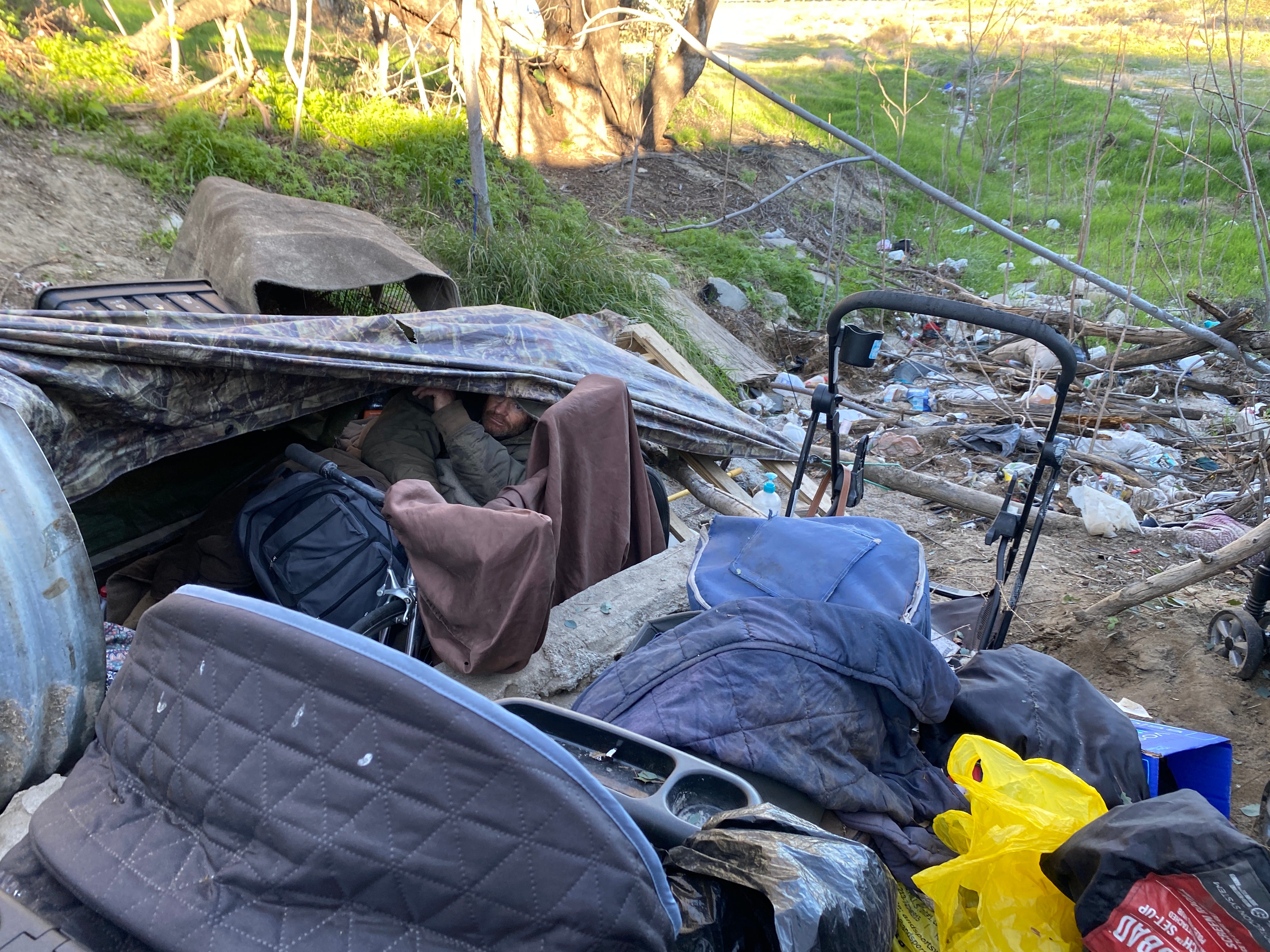
The new outreach efforts seemed to be paying off. There was a sense of cautious optimism that the city’s new initiatives were helping get ahead of the growing crisis of homelessness in California.
Then, in April, the results of the 2023 Point-in-Time Count and Survey were published.
In Redlands, the reported number of people living on the street has skyrocketed. According to the 2023 count, there has been a 76% increase in unhoused individuals in Redlands compared to the same time last year.
On the morning of Jan 26, 2023, volunteers counted 244 individuals who had spent the night outside, up from 99 in 2022. This year's total count for Redlands, including both sheltered and unsheltered persons, was 324, up from 184 in 2022.
The 2023 report has the largest year-over-year increase in the past ten years.
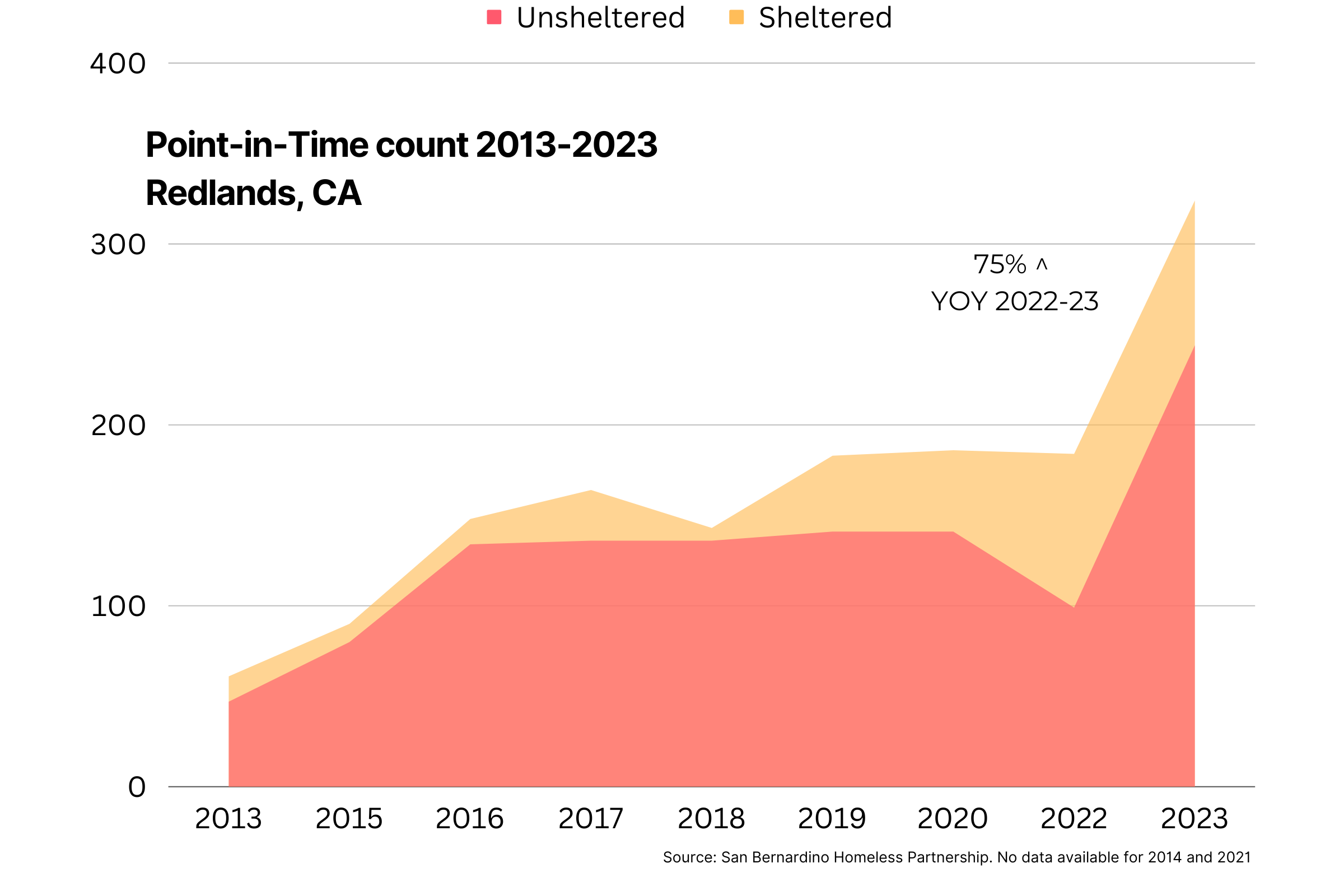
Here are five key takeaways about Redlands from the 2023 Point-in-Time Count and Survey
ONE: The number of homeless persons in Redlands rose at a higher rate than in the county. County-wide homelessness has risen by 26% since last year, compared to the 76% increase in Redlands.
TWO: Cities across the Inland Empire are experiencing a rise in homelessness. However, the numbers in Redlands are disproportionately high compared to the total population. For example, the cities of Fontana and Redlands counted a similar number of unsheltered people (240 and 244, respectively). However, the population of Fontana (210,700) is more than double that of Redlands (73,200). Both cities also have city-run homelessness outreach programs.
THREE: Only a small percentage of people surveyed said they "first became homeless" in Redlands. Surveyors gathered responses from 1,732 adults experiencing homelessness across San Bernardino County. When asked, 'In what city did you first become homeless?' just 64 people (3.7%) named Redlands. For comparison, about 556 (32%) people stated the city of San Bernardino and 107 (6.2%) answered Fontana.
FOUR: This year more people reported becoming homeless in the last 12 months than during last year’s survey. In Redlands, when asked, 'Did you become homeless for the first time during the past 12 months?' 26% answered yes, compared to 13% in 2022. The county saw a similar rise in first-time homelessness in the last 12 months, up 13 percentage points from a year earlier.
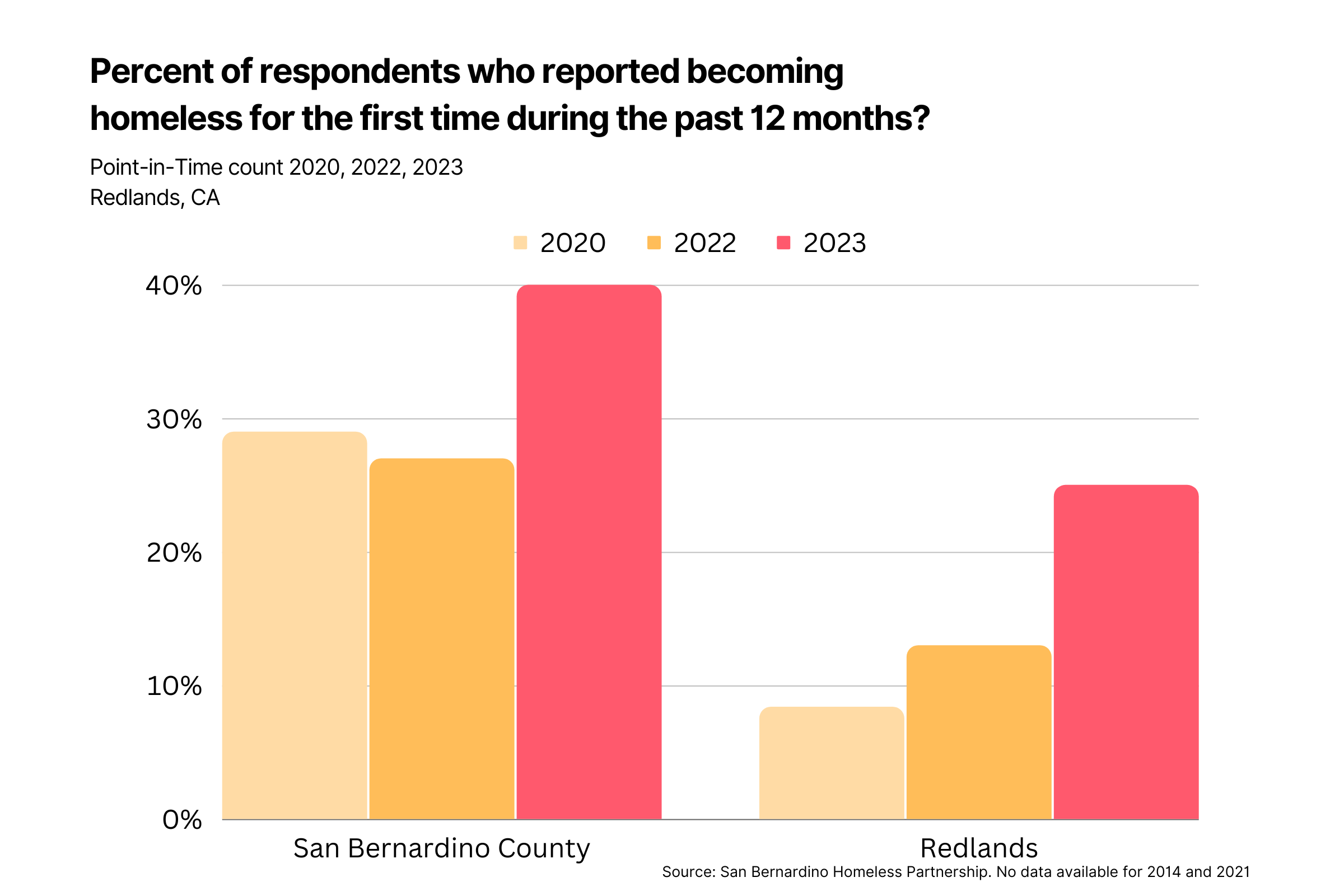
FIVE: Of the 47 jurisdictions surveyed in San Bernardino County, seven cities account for the majority of the county's homeless population. More than three-fourths (76.9%) or 3,226 of the 4,195 unhoused adults and children were counted within seven cities, including Barstow, Colton, Fontana, Ontario, Redlands, San Bernardino, and Victorville. Of these cities, the Redlands point-in-time count rose by the highest percentage. The second highest percentage rise was in Fontana, which went up by 54%.
Response from local officials
The city of Redlands attributes the drastic increase in the number of unhoused to more accurate data collection.
This year was the first time that the city's new Homeless Solutions Coordinator, David Rabindranath, organized the PIT survey. According to city staff, the sharp rise in numbers is due to the effectiveness of the city’s outreach and the number of volunteers that came out to help with the count.
"The accuracy of the Point-in-Time Count depends in large part on how effective the counters are in reaching the target population," Carl Baker, city of Redlands Public Information Officer, wrote in response.
Nearly 90 volunteers showed up to help conduct the survey. This was one of the largest groups in recent years.
Baker also credits the city's overall increase in outreach with a more accurate count of the homeless population compared to years past.
"The recent addition of the Homeless Solutions Coordinator and the city's preparation for opening the Step Up in Redlands supportive housing project resulted in far more extensive outreach efforts. As a result, we believe this year's count was far more accurate than previous years," said Baker.
In addition, the new Step-Up supportive housing project, which began taking applications in January, was not filled until the end of March. This means some of the unhoused people counted in Redlands PIT count would have received housing by this point in the year.
This housing project accounts for 98 permanent supportive housing units and is currently occupied by 120 individuals. You can read more about it here.
The point-in-time count shows the city's progress in helping chronically unhoused residents is being outpaced by the increasing number of unhoused people in the area.
Zoom out: California Homelessness Crisis
The state of California has a homelessness problem. Despite recent efforts, it's not getting much better. According to recent data, California is home to more than 160,000 unhoused people, accounting for nearly a quarter of the country's homeless population.
The state is spending hundreds of millions of dollars to get people off the street. A recent report revealed the state spent nearly $10 billion over three years. The state's Interagency Council on Homelessness took a closer work at how the money was spent and what worked.
The report found that the funds helped about a half-million Californians from 2018-2021. More than 40% of those who used the funds ended up housed. However, the majority either remained unhoused or the state lost track of them.
A look at what's working
The statewide report sheds light on the effectiveness of permanent supportive housing initiatives, with promising results. About half of the total sitewide funding ($5 million) from 2018-2021 addressed affordable housing.
Out of the over 75,000 individuals who were placed into some form of permanent supportive housing across the state, only 8% returned to living on the streets within six months.
In contrast, the study found that individuals who left a state-funded program to live with friends or family had a doubled rate of returning to homelessness within six months. And for those who left for a rental with a temporary subsidy, the rate of returning to homelessness was even higher, at 23%.
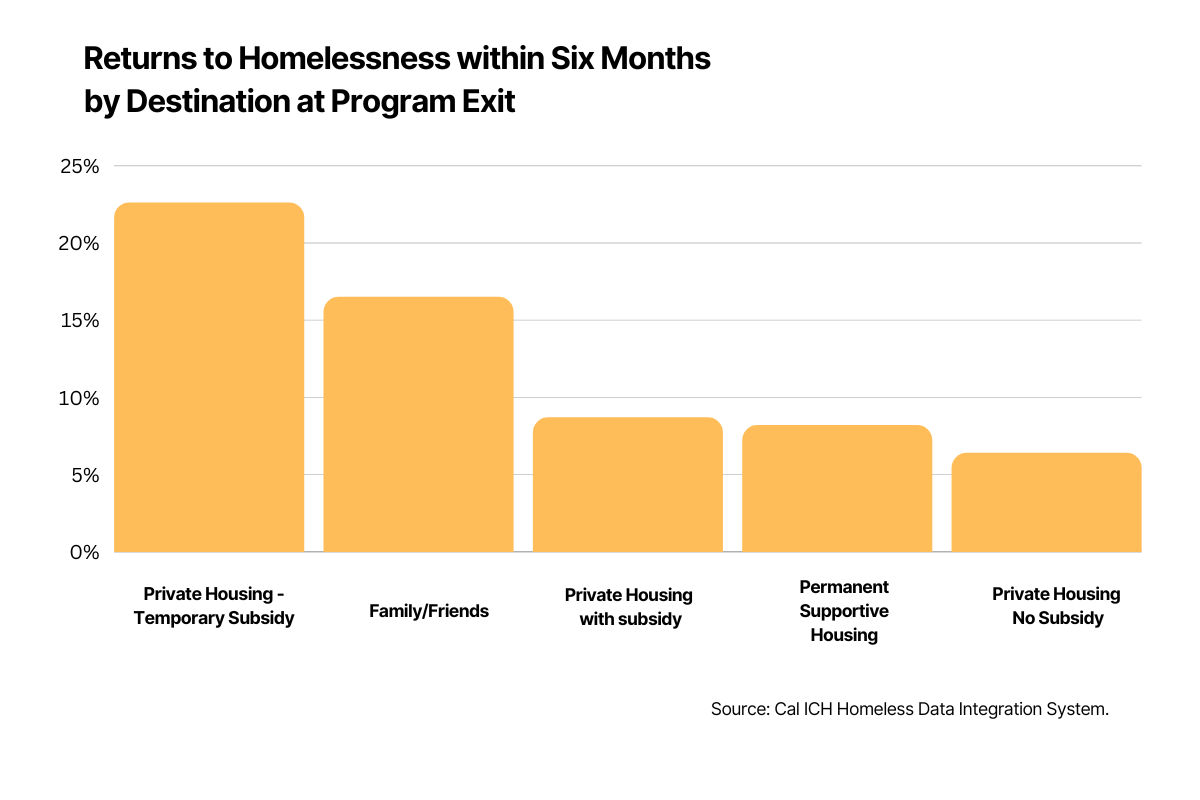
These findings highlight the importance of permanent supportive housing as a key solution to homelessness, providing not just a roof over one's head but also access to support services, such as health care and counseling. Such initiatives offer a pathway to stability and independence and can help break the cycle of homelessness that can be difficult to escape.
The state has invested millions of dollars in programs like Project Homekey, which converts hotels and motels into permanent supportive housing for people experiencing homelessness. Homekey has created 12,774 permanent and interim homes through 210 projects across the state.
In 2022, the city of Redlands received a $30 million Homekey grant for permanent supportive housing. The city partnered with Shangri-La Industries and Step Up on Second, Inc. to purchase the former Good Nite Inn. The motel was converted into 98 studio units for long-term permanent supportive housing for the chronically unhoused in Redlands.
In March, Governor Newsom announced another $736 million to fund the Homekey program across the state.
The city plans to address the recent PIT survey results in Redlands by "continuing [our] outreach efforts, which includes working with the County, local nonprofit service providers, and other agencies,” said Baker.
How you can help
You can find more information on local efforts to help and support people experiencing homelessness in Redlands here.
Find resources to support unhoused individuals here.






